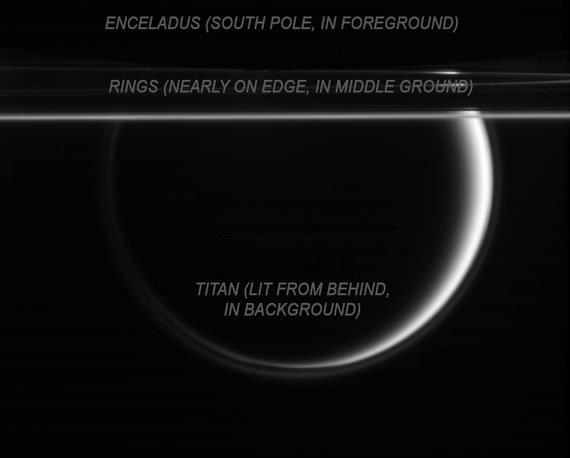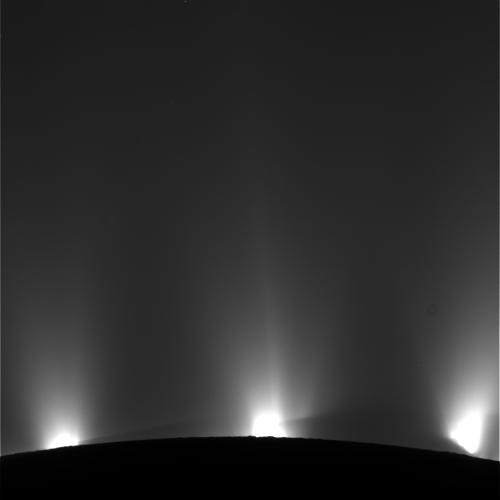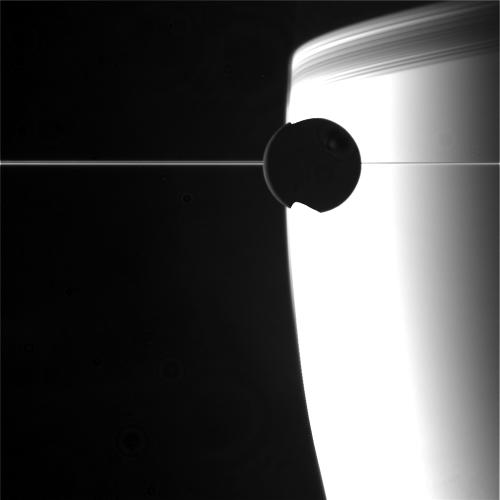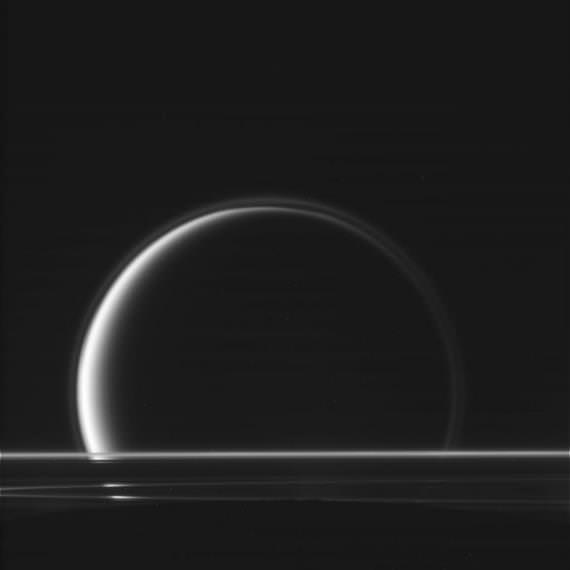[/caption]
Wow. Cassini the artist has struck again, this time with amazing images from the close flyby of Enceladus that we wrote a preview about earlier this week. Cassini flew by Enceladus during the early hours of May 18 UTC, coming within about 435 kilometers (270 miles) of the moon’s surface. The raw images came in late last night, and in my inbox this morning was an email from Stuart Atkinson, (no relation, but great name) alerting me to the treasures. Stu himself has called this image “the new iconic image of the space age,” and Emily Lakdawalla of the Planetary Blog has called these images “some of the most amazing Cassini has captured yet.”
What you’re seeing here is hazy Titan, backlit by the Sun, with Saturn’s rings in the foreground– plus, at the way bottom is the limb of the night side of Enceladus’ south pole. Emily has created a flipped, annotated image (plus there’s more Enceladus jaw-droppers below:


Three huge “fountains” of Enceladus geysers are visible in this raw image taken by Cassini on May 18, 2010. The camera was pointing toward Enceladus at approximately 14,972 kilometers away, and the image was taken using the CL1 and CL2 filters. Emily, with her photo editing prowess, has created a movie from four different images as Cassini cruised closer to the moon.
Astro0 on UnmannedSpaceflight.com has put the two different images together to create a collage of what it would have looked like if the plumes were visible in the image with Titan. Gorgeous! Plus, here’s a color version Astro0 created.
Plus there’s this very interesting raw image from Cassini:

Explanations anyone?
Cassini will be flying by Titan in the early hours of May 20 UTC, coming within 1,400 kilometers (750 miles) of the surface. Although Cassini will primarily be doing radio science during this pass to detect subtle variations in the gravitational tug on the spacecraft by Titan, hopefully we’ll see some new visible light images of Titan, as well.
For more images from Cassini, see the Cassini website, and the section for the raw images.


Sometimes I feel like a one-trick pony for posting so many images from Cassini, but with stuff like this coming in almost weekly, how can you not get excited about it? The Cassini mission is just incredible, and the ability for anyone to see the images basically as they arrive is pretty much the best thing ever.
What can I say. I luvz Cassini.
I used two raw images to make a version of the one above – Enceladus along the rings – where the bloom from overexposure isn’t eating into the moon’s edges. (http://lightsinthedark.wordpress.com/2010/05/19/through-the-plumes/).
Amazing work by Astro0 and Emily!!! And of course, the Cassini team.
Mimas? But the raw data sez Cassini was “pointing at” Enceladus. ?
I’m not sure if that’s the Death Star Dent or just crud on Cassini’s camera…or a glare artifact. Still not 100% sure it’s Mimas…
Could the shadows on Enceladus’ plumes be caused by out-of-view landforms just over the curve of the moon’s limb? Do the plumes themselves cast shadows?
“Plus there’s this very interesting raw image from Cassini:” The Cassini web site says this was taken through two filters. Perhaps the moon moved enough between exposures to create this effect.
The explanation for the last image is quite simple. On the area where sun is heavily reflected from Saturn, the image pixels are saturated. As often happens when an image includes bright light sources. And, as usually happens when there’s saturation, the saturation area “bleeds” to adjacent pixels. The “dents” in that moon (which one is it, BTW? seems to be rather dark) are simply the result of bleeding from the most saturated areas in Saturn’s crescent. And the more saturated they are, the larger the dents become.
That would be Mimas. =D
I got this email from Emily Lakdawalla on the last image,: Commenter Jorge is correct. I’d add to his explanation is that this is something that cannot be calibrated out; pixel bleeding is an irreversible sort of “damage” to an image and something that planners typically avoid if they can help it. But sometimes it can’t be helped — you have to set the exposures long enough to catch something faint, and something else bright in the image causes the bleeding.”
Thanks Emily!
That’s no moon. Its a space station…
Look closely, and you will find the characteristic “dent” of the Deathstar. Yep… Its definitely the Deathstar. We are all gonna be toast once they are done building it.
I’m still puzzled by the third image above, labeled “The ‘fountains’ of Enceladus.” Emily’s description of this image noted “There are some odd shadowing effects in the background that I don’t quite understand.” Me too! Any suggestions?
Jon, the way I see it, it’s like this:
The fountains are not point sources; rather, they are coming from several openings in the “tiger stripes”. There are, therefore, a number of geysers erupting linearily, and more or less along the line of view of Cassini.
Some of these linear geysers, those that are more distant from Cassini are fully (back)lit, as they are erupting from the dayside. Others, however, those that are closer to Cassini, are erupting from the nightside, and so only the top part of the plumes gets lit by the sun. That linear difference in lighting marks the place where the shadow of Enceladus’ rim cuts the plumes.
That’s how I see it, anyway. Seems logical.
Waddaya say, Emily? 🙂
Pity Arthur C. Clarke isn’t around anymore. He would have been overjoyed with such an image – matching his love and fascination with fellow moon, Iapetus!